Sponsored by
We are currently seeking a sponsor for this website
as it follows the progress of the excavations on the battlefield, with contributions from established historians and well known experts, as the team attempt to match the historical evidence and family history to the archaeology on the ground.
If you enjoy this website
please consider making a donation towards the costs of the project.

|
Magazines (the literary sort) Friday, September 10th, 2010
|
|
|
|
|
The project currently features in the two leading archaeological magazines in Britain.
_
British Archaeology includes a piece on Alan Mather’s identification.
_
Meanwhile Current Archaeology includes seven pages on the Plugstreet Project with maps, photographs and other illustrations.
_
You can find British Archaeology in some larger newsagents and supermarkets and Current Archaeology is available via its publishers:
www.archaeology.co.uk
_
There is also a feature in the August edition of Britain At War
_
|
|
|
|
|
|
Filed under: A Dig Diary by
Martin
Add a Comment »
|
|
Avril’s Trench Tuesday, August 17th, 2010
|
|
|
|
|
In July, Avril’s team returned to look at the area of communication trench examined in part in 2009. More of this comms trench was uncovered with its postholes and armoured cable and ceramic insulators. In addition fragments of light bulb were recovered. The team also excavated a hearth and a timber floor into which a further brick-lined hearth was set. Close to this was a Schnapps glass, the remains of a cauldron and there was evidence for shell damage. It is tempting to think of the German garrison trying to make the best of rations in their front line yet at the same time providing a smoke signal as to their whereabouts for British artillery. There is still much to be learned about this area of the excavation…
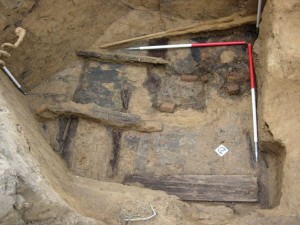 - Timber flooring and a brick-lined hearth in Avril’s area
Â
Â
|
|
|
|
|
|
Filed under: Archaeology by
Richard
Add a Comment »
|
|
Wreaths and epitaphs for a soldier. Tuesday, August 10th, 2010
|
|
|
|
|
“So far from home, never forgotten, may you rest in peace bearing an honoured name.”
It was with those words, the family of Alan James Mather, left his remains in a quiet cemetery in Belgium surrounded by wheat and cornfields and grazing cattle.
Listen to a radio interview with Kim Bloomfield, great grand niece of Alan Mather, speaks about their experiences in Belgium.
|
|
|
|
|
|
Filed under: A Dig Diary by
PlugStreetTeam
Add a Comment »
|
|
Team Nosferatu’s epic descent Tuesday, August 3rd, 2010
|
|
|
|
|
Nosferatu swung into action again this year after Jon’s unavoidable 2009 absence in the Occupied West Bank. Team this year was mostly old veterans and fully international. Returnees were Keith (Britain), Paola (Italy), James (USA), Swantje (Germany), Nicolas (Wallonie) and new arrival Christine (Britain).
_
In order to raise the tone of what might otherwise be an unseemly display of grubbiness we dressed for lunch each day in No1 mess dress black high vis. We were promised a machine, and were very excited about it digging down to where we left off in 2008. Unfortunately the bosses seem to have found it in a Kinder Surprise and it barely managed to take out 500mm. And so the epic descent began.
_
Finds were few, though they included the Australian shoulder title and several bullets which were badly distorted after ricocheting off Kirsty’s concrete blockhouse. When we finally hit the top of the feature there was heavy wood galore. This included a possible door with embedded .303 bullet, and heavy mortice and tennon joints. In situ was a pump for drinking water. Apart from being broken this was in perfect condition as we had reached a nice blue anaerobic layer. This also produced a roll of paper. The finds team will excavate it back at Bradford, but we believe it is either a mediaeval manuscript looted from Brugge, or a toilet roll.
_
 Cleaning up after the machine  Back to 2008 part 1 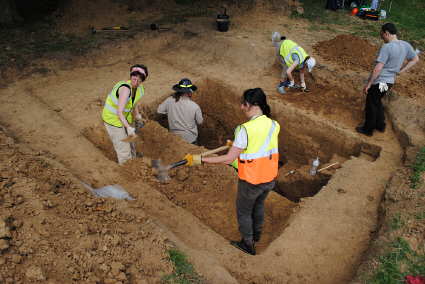 Back to 2008 part 2: The Descent Continues  Back to 2008 part 3: Hitting Plastic  _
_
 Extending the staircase 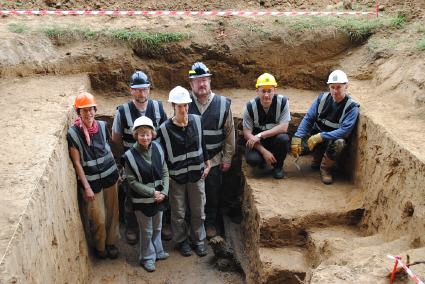 Setting the tone  Getting stuck in to the anaerobic layer
|
|
|
|
|
|
Filed under: A Dig Diary by
Nosferatu Actual
2 Comments »
|
|
A Director writes (2) Monday, August 2nd, 2010
|
|
|
|
|
Monday evening, back in the UK, time for a swift resume of the year.
_
The remarkable start to the season was, of course, Alan Mather’s funeral and the opportunity to meet and make friends with his lovely family – if you’re reading this here are some big hellos and hugs from the other side of the world. The privilege of seeing this part of our research come to such a striking and meaningful end was enormous.
_
This year we were able to open two separate areas, with two trenches in each. At Ultimo crater we re-opened two trenches from previous years. Avril investigated further areas of her German communication trench and its associated alcove/shelter that seems to have been used as a housing for electrical or telephone equipment. It also included remains of a rudimentary hearth and a small cauldron, so it looks like the German sparks had a constant brew going.
_
Meanwhile Jon’s team were able to go back into what we though was either a mortar pit or a shallow dugout. However, following a bit more research and a chat with Johan Vandewalle we now think we are looking at a destroyed tunnel, perhaps leading to an incline to a deep dugout.
_
Over at our new site we looked at two German trenches, one on a piece of the third line of the German A stellung (front defence), and the other looking at a German communication trench running back to it from the second line. Steve and team on the fire trench found evidence of some serious shell damage, as well as some rather older pottery than 1914, showing that this was an old landscape by the time the armies arrived. Kirsty’s team looked at the Comm Trench. It had been created in an older ditch running from a medieval moated site. Both had unusual U shaped concrete ducts or gutters in them.
_
Meanwhile, the Finds team up at Messines worked on the material we produced and found time to conserve a wonderful Lee-Enfield rifle found during building works at a nearby farm and donated to the local museum in Warneton.
_
At the same time the two Peters walked miles in the landscape doing, respectively, their geophysics and map work, as well as further project-related art work.
_
A few Thank You’s:
- Nelly and Claude at the Auberge Nelly et Claude, Ploegsteert, for friendship and amazing food.
- The Peace Village Messines for looking after us so well.
- Liz and Gen for their sponsorship.
- All our new Australian friends.
- Both our lovely welcoming farmers! Without whom none of this would happen. A la prochaine…
- Everyone in the team (including the dog) in whatever role – you made Richard and my lives so much easier and our holiday so relaxed.
_
|
|
|
|
|
|
Filed under: A Dig Diary, Archaeology by
Martin
3 Comments »
|
|
Traces of History Wednesday, July 28th, 2010
|
|
|
|
|
Reading letters sent home from the trenches, many soldiers describe the Belgian landscape as being similar to England. Gentle rolling fields dotted with sparse farms, narrow lanes and familiar trees. Today the fields have been restored to their pre-war state and farmers tend the crops as they have for a thousand years, for this is an old landscape, briefly disturbed by the war. Our trenches on the German third line remind us of this, evidence of the trenches is mixed with shards of Roman and medieval pottery left by those who called this place home. The older archaeology obliterated by the battle, leaves us wondering if the men who dug these impressive fortifications were aware of these traces of the past; evidence from other sites suggests that some of them were.
|
|
|
|
|
|
Filed under: A Dig Diary by
admin
1 Comment »
|
|
A co-Director writes….. Tuesday, July 27th, 2010
|
|
|
|
|
Hmmmmm
_
Well, as readers will have perceived the morale of the teams is high, despite baking heat, thunder and lightning and the mercurial and arbitrary decisions of the bosses.
_
Seriously, everyone has done incredibly well. Finds are telling an interesting story, including the Roman and medieval material found redeposited in Steve’s trench, which tells the ancient landscape in which the war was fought. Meanwhile, the structures show us much about how much the armies changed the geography between 1914 and 1918, sometimes in ways we didn’t expect, such as the concrete guttering or the reuse of much older landscape features.
_
Two more digging days to go and still much to expect, including the solution to the mystery of what lies beneath the timber in Jon’s trench.
_
Keep Watching!
|
|
|
|
|
|
Filed under: A Dig Diary, Archaeology by
PlugStreetTeam
Add a Comment »
|
|
From Damier Farm Tuesday, July 27th, 2010
|
|
|
|
|
2010 saw the start of excavations on a new site courtesy of Monsieur Lefebvre.
_
2 trenches were opened following geophysical survey to explore German trenches. One of them, located on the third line of the German first line of defences, has revealed a wide fire trench with traverses. In the bottom of this trench we have found a U-shaped concrete lined drain or conduit for cables constructed from prefabricated sections. The trench also showed evidence of shell damage including the 1916 dated fuze of a British shrapnel shell.
_
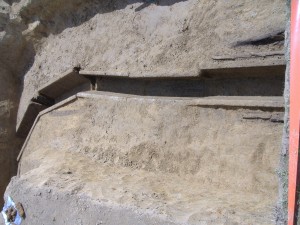 concrete drain or conduit _
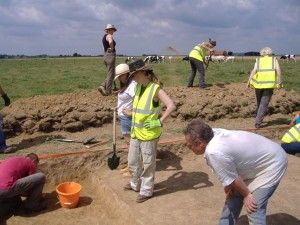 A head scratching moment! _
A German communication trench is also under investigation; this feature reused a pre-existing drainage ditch that was converted to military use. Today excavation revealed trench boards in the base of the main east-west trench and a second trench cutting in from the north. The latter had been badly damaged by shell fire and appeared to have lain unused for some time.
_
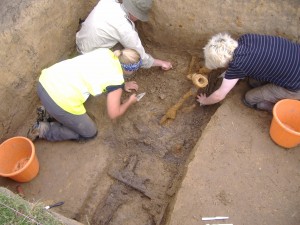 Trench Two; Trench Wenches at work (and Henry!)
_
|
|
|
|
|
|
Filed under: A Dig Diary, Archaeology by
Kirsty's Team
1 Comment »
|
|
Thank you! Tuesday, July 27th, 2010
|
|
|
|
|
_
A big thank you to Claude and Nelly of L’Auberge Ploegsteert for providing the Team with delicious lunches and evening meals through out the dig.
_
|
|
|
|
|
|
Filed under: A Dig Diary by
PlugStreetTeam
Add a Comment »
|
|
Rain Stopped Play Tuesday, July 27th, 2010
|
|
|
|
|
Thunder storms are a bit of a thing while we are in Belgium, this afternoon saw dark clouds rolling across the fields towards us.
_
_
Dark clouds bringing heavy rain, swirling winds and the rumble of thunder. A gentle rumble this time, nothing like the sharp crack of thunder which woke us on Thursday night a matter of hours after we had laid Alan Mather to rest in the peaceful place that is Prowse Point, or the violent cracks that echoed over the battle scarred landscape the night after we had found him, as the team stood guard over the site.
_
It may be a coincidence, but in the emotion soaked fields where men lived and died, there is an evocative echo of the big guns perceptible in nature’s voice.
_
|
|
|
|
|
|
Filed under: A Dig Diary by
admin
Add a Comment »
|
|
|
|
|
|